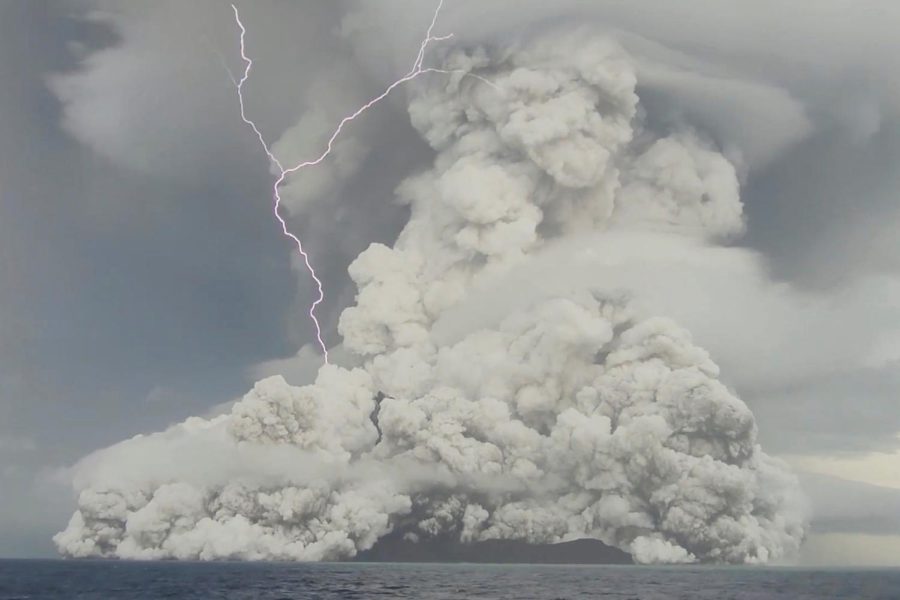Tsunamis Around the Pacific – Tonga’s Volcanic Eruption
One of the lightning sightings during Tonga’s volcanic eruption.
February 6, 2022
On Jan. 14-15, Tonga shook the world with the eruption of the underwater volcano, Hunga Tonga-Hunga Ha’apai.
On Jan. 14, 2022, at 4:20 a.m. local time, a sub-aerial eruption occurred, creating a mushroom-shaped cloud of ash, steam, and gas that rose as high as 20 km (65,600 ft), reaching a diameter of 240 km (750,000 ft). The next day at 5 p.m., a larger submarine eruption began that caused an eruption plume that rose approximately 15.2 km (50,000 ft) and expanded around 600 km (2 million ft) in diameter at 9:03 p.m. There were almost 400,000 lightning sightings from 5:19 to 11:00 p.m. in the plume, with 200,000 of them occurring from 6:00 – 7:00 p.m. By 3:43 a.m. on Jan. 16, the plume had risen to 19.2 km (63,000 ft).
The Smithsonian Institution explains, “Tsunami waves 2-15 m high, based on a news article and the official report, arrived on the [West] coasts of the Tongatapu, ‘Eua, and Ha’apai islands, and three people in Tonga were confirmed to have died as a result, with many others injured. Extensive damage was reported on Mango, Fonoifua, and Nomuka islands, and the [West] part of Tongatapu. According to a news report, the small island of Atata, near Nuku’alofa, had been completely submerged.”
There were also several tsunami warnings in several other countries around the Pacific Ocean. “Several news sources reported flooding and damage caused by tsunamis at locations as far away as Peru (over 10,000 km), where it caused two deaths. Warnings were issued for the [North] and [East] coasts of New Zealand’s North Island and the Chatham Islands. Thousands in Japan evacuated after tsunami warnings, and the waves there reached 80 cm. In Anchorage, Alaska, the US National Weather Service reported maximum waves heights of 20-100 cm on Alaskan coastlines, and along the British Columbia coast, waves were 16-29 cm on 15 January,” the Smithsonian Institution confirms.
The Jet Propulsion Laboratory also states, “When the Hunga Tonga-Hunga Ha’apai volcano erupted on Jan. 15, 2022, it unleashed a violent explosion with the equivalent force of 4 to 18 megatons of TNT, according to estimates from NASA geologist Jim Garvin. This explosion produced an acoustic shockwave that was strong enough to perturb the ionosphere, the outer layer of the atmosphere that starts about 50 to 56 miles (80 to 90 kilometers) above Earth’s surface and contains electrons ionized by the Sun’s energy.”
Tonga’s eruption shook the world, leaving everyone agape at the power of Earth’s natural disasters.
Information from:
https://www.jpl.nasa.gov/news/tonga-eruption-sent-ripples-through-earths-ionosphere


